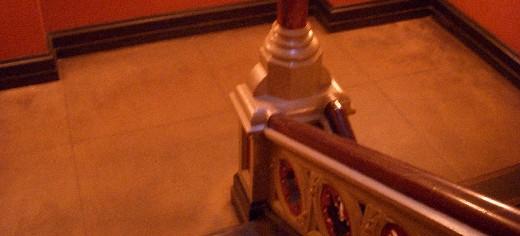Walkalog: at the Museum

An old stairway at the Metropolitan Museum of Art — an outcrop of the buried original.
This afternoon, not having been in a while, I walked over to the museum. It was agreeably underpopulated for some reason, although there were still plenty of small knots of people stopping in the middle of the traffic, unaware that New York pedestrians follow rules of the road. If you want to stop and get your bearings, you pull over. Oy.
As I was on my way to see my favorite picture, only to find that it’s out on loan for a while, I reflected that, much as I love to meet people at the museum, I prefer to go through the galleries by myself, because that’s the only way to rule out talking. If it were up to me, the museum would be as silent as a church in a pentitential season. I have overheard a lot of claptrap at the museum, some of it uttered by myself, but never anything worth attending to.
The great name of Andre Meyer has been retired, it seems, and the galleries of Nineteenth-Century European art that used to bear his name have been tweaked, expanded, and partially renamed. The change is a great improvement, if for no other reason than the sensible incorporation of a great deal of American and Twentieth-Century art that belongs alongside the impressionist, pre-, and post- pictures that were already there. For example, Sargent’s Madame X, formerly rather hard to find, tucked away in the American Wing, now commands the best spot in the house, and can be seen for miles, which is just as it should be, since everybody wants to see her. Picasso’s portrait of Gertrude Stein is very much at home a room or two away. I am not entirely sure about the installation of an Art-Nouveau dining room from a house near the Place de l’Étoile; it’s very handsome, but surely it belongs among the exhibits of decorative arts on the ground floor. A quibble.
There’s a nice little show of drawings and etchings in the Johnson Gallery (that corridor that connects the top of the grand staircase with the lobby of the old Andre Meyer galleries), a pendant to the soon-to-open Poussin and Nature. My favorite is a drawing by Donato Creti — no, I hadn’t heard of him, either — “Bathers in a Woodland Landscape.” You’d miss the bathers if it weren’t for the title; they’re lost among the tree trunks in the background. The only clear figure is that of a gentlemanly rustic drying himself off on a rock. The whole scene is shot with the bright peace — and even the fragrance — of a summer afternoon in the woods.
Two other nice works: an etching by Joseph Rebell (d 1826) that, with its pale, distant bluff, roundly prefigures the Hudson River School (which isn’t saying as much as that might sound, since the HRS is mightily retrospective); and an anonymous Seventeenth-Century French drawing of some architectural ruins that strongly suggest the Met in a makeover for one of those apocalyptic movies going round these days. I’d have bought the catalogue, but of course there wasn’t one; there never is for this sort of show, drawn entirely from the Museum’s collection.
